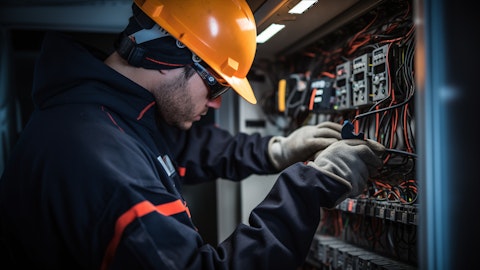Daniel Jones: Yeah, aluminum is a — it’s an odd product comparatively speaking to copper. Copper is mined and aluminum is manufactured. And there’s no secret we’ve always focused on copper. We do a very good job in aluminum. It’s a tight market, no question. There’s a big influence from a pricing perspective, not to the positive. When the importers have inventory, I don’t think it’s any secret that they lead with price. We pick and choose our spots. We’ve got fantastic partners in the market that we do great with on aluminum, but we’re not going to chase our tail on some of those projects, that fringe projects a lot of times that end up going to the discounters. And not my style to cut price. Our model is about service. It comes and goes ebbs and flows, but it’s a product that we do very well in.
We have to have it. It’s still very profitable for us. And it’s just a little bit more volatile than it has been in the past. And the government’s looking into things as they have in the past. And it’s just a constant fistfight on that product category. But the XLPE plant, the addition of that will give us a little bit more strength, a little bit more control over where we go with that product and direct that market a little bit better.
Brent Thielman: Okay. And just on the CapEx, maybe, Bret. Could you just differentiate the sort of maintenance sustaining CapEx versus growth CapEx and that outlook for year ’24?
Bret Eckert: Yeah, I appreciate that because — appreciate the angle you’re taking with that. And it’s one that, again, you got to say, give me your definition of maintenance CapEx, right, because we spend $40 million to $60 million in any given year, right, that I would call maintenance CapEx. But I’m going to tell you that’s vastly new machinery and equipment, right. We don’t like to retire equipment. We like to find a spot on the floor and bolt another line next to it, right, as you go through it. So you’re always evaluating your current machinery and equipment. You’re working closely with our maintenance times to manage any sort of downtime. You’re looking at line speeds in the new equipment versus the old equipment. You’re looking at how much energy it draws and can something be more efficient on a go forward basis or safer?
And those are decisions we look at as we look for repair, replace. That’s what I include in that $40 million to $60 million. I think some folks would say just pure maintenance CapEx. It’s much lower than that. But we consistently, if you look back in our capital, it would be anywhere from that $40 million, $50 million, $60 million and its consistently new machinery equipment over the years.
Brent Thielman: Okay, very good. Thanks, guys.
Daniel Jones: Thanks, Brent.
Bret Eckert: Thanks, Brent.
Operator: (Operator Instructions) Our next question comes from the line of Matt Jackson of Scopia Capital. Please go ahead.
Matt Jackson: Hey, how’s it going? I was just hoping you could give the LIFO impact in the quarter? Was that a negative or a positive? Thank you.
Bret Eckert: Well, yeah, in the quarter and keep in mind you had an environment where copper was rising throughout the quarter. And so in the fourth quarter, it was a pickup of about just under $2 million. It was pretty significant. If you compare it to the third quarter, it was a pickup of about $5 million, that’s just a product. It really is more of a balance sheet effect, right, because you’re costing your orders at your beginning of month price and so depending on what copper does up or down, you’re just adjusting to make your — to match your revenue with your expenses within that month. And so it was a small pickup, but again it’s — because we turn our finished goods inventory over 12 times, it’s the perfect hedge out there by the material change, the shape and ship it in the same month, you cannot beat that business model.
Matt Jackson: Thank you.
Operator: Thank you. There appeared to be no further questions at this time. Mr. Bret Eckert, I turn the call back over to you.
Bret Eckert: Bhavesh, thank you so much. I appreciate everyone’s participation today. Thank you for your investment and your interest in Encore Wire. Enjoy your day.
Daniel Jones: Happy Valentine’s Day.
Operator: Thank you very much. This concludes today’s conference call. We thank you for participating and you may now disconnect.
Follow Encore Wire Corp (NASDAQ:WIRE)
Follow Encore Wire Corp (NASDAQ:WIRE)
Receive real-time insider trading and news alerts



